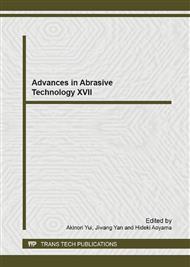p.539
p.544
p.549
p.553
p.559
p.565
p.573
p.580
p.586
Study on the Flow Pressure of Mass in Centrifugal Disc Finishing
Abstract:
A pressure sensor is developed to explain the finishing mechanism in centrifugal disc finishing. The distributions of the flow pressure of mass in the radial direction and the height direction of the barrel are investigated. The flow pressure of mass is higher in the lower layer near the disc than in the upper layer, regardless of the finishing conditions. In the upper layer of the mass and near the side wall of the barrel, the flow pressure of the mass of the wet process is higher than that of the dry process. However, the stock removal of the dry process is larger than that of the wet process.
Info:
Periodical:
Pages:
559-564
Citation:
Online since:
September 2014
Price:
Сopyright:
© 2014 Trans Tech Publications Ltd. All Rights Reserved
Share:
Citation:


